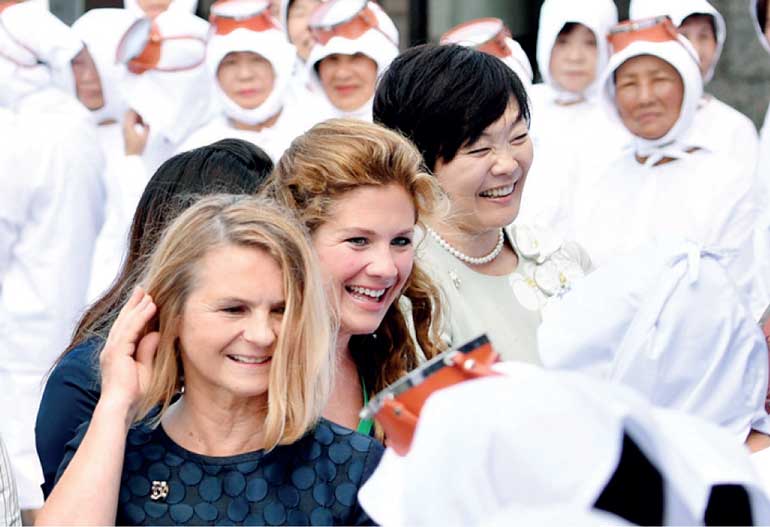Tuesday Dec 23, 2025
Tuesday Dec 23, 2025
Monday, 30 May 2016 00:00 - - {{hitsCtrl.values.hits}}

(From L) German Chancellor Angela Merkel, Italian Prime Minister Matteo Renzi, Japanese Prime Minister Shinzo Abe, European Commission President Jean-Claude Juncker, US President Barack Obama, European Council President Donald Tusk, Canadian Prime Minister Justin Trudeau, French President Francois Hollande and British Prime Minister David Cameron walk out to the family photo event during the first day of the Group of Seven (G7) summit meetings in Ise Shima, Japan, May 26, 2016. REUTERS

Partners of the G7 summit meetings participants Malgorzata Tusk (L), wife of European Council President Donald Tusk, Sophie Gregoire-Trudeau (C), wife of Canada's Prime Minister Justin Trudeau, and Akie Abe, wife of Japanese Prime Minister Shinzo Abe, talk with female divers known as 'ama' in Japan as they visit Mikimoto Pearl Island in Toba, Mie prefecture, Japan, during a spouses program of the sidelines of G7 summit meetings, in this photo taken by Kyodo May 26, 2016 - Kyodo/via REUTERS
Pick up the torch which German Chancellor Angela Merkel shone on women’s empowerment by including it on the G7 Agenda at the 2015 summit, Japanese Prime Minister Shnizo Abe, the sitting Chair of the G7 meeting at Ise-Shima, has pledged to make Japan a “society where women shine”.
Stating that it is something he is determined to accomplish, he revealed that he will stress on the resonance that this holds internationally.
“It is a truism to say that the entire world is going to be a far happier place when one half of its population feels better off as regards employment and education, science and technology and achieving peace,” he said.
Since Japan is leading the G7, it has a unique opportunity to become a positive template for other nations facing similar challenges. The information from Japan on ‘Womenomics’ is a case in point for Sri Lanka to make note of.
Last year’s summit produced concrete outcomes on:
Holding the G7’s presidency this year, the Japanese Government continued its efforts on the ‘Womenomics’ program. The labour participation rate for women in G7 countries has climbed sharply from just 66.5% in 2000 to 74.5% in 2014. And the number of working women in Japan has risen by one million in the past three years.
The following are some of the key initiatives under Japan’s ‘Womenomics’ program;
Secure an additional childcare capacity for approximately 5,000,000 children by the end of FY 2017.
Increase childcare leave benefits from 50% to 60% of the salary for the first six months of leave.
Increase the proportion of women in management positions to 30% by 2020
Oblige enterprises to create an action plan for the participation and advancement of women
Promote corporate initiatives to correct the practice of prolonged working hours.
Sri Lanka’s female labour force participation rate is 35% and is very much behind almost all Asian countries. The high literacy rate of 92% and exceptional educational achievements do not show much bearing in the economic participation, indicating the gaping disparity between potential economic productivity and available human resource. Increased women’s economic participation has been called for as essential to sustain the desired economic growth momentum and to achieve the overall economic prosperity of the nation.
 This would also be in keeping with the UN’s Sustainable Development Goals which seek to ensure that all human beings fulfil their potential with dignity and equality while paying attention to achieving gender equality and empowering all women and girls.
This would also be in keeping with the UN’s Sustainable Development Goals which seek to ensure that all human beings fulfil their potential with dignity and equality while paying attention to achieving gender equality and empowering all women and girls.
Kathy Matsui, Vice Chair and Chief Japan strategist at Goldman Sachs Japan, says that in 1999 as a part of the solution to Japan’s demographic crisis, a higher female participation was proposed, at which time it stood at 57%,–among the lowest in the developed world.
Japan stood out from its developed country peers with its pronounced ‘M-curve’ of female employment reflecting the fact that over 60% of Japanese women quit working after giving birth to their first child and typically stayed out of the workforce until their children were grown.
Despite this, however, few paid attention to this issue and the term ‘diversity’ was not part of the Japanese vernacular. The prevailing views were that low female employment was simply a fact of Japanese life and for a variety of reasons – most of them cultural – the system would be impossible to change.
Lessons for Sri Lanka
Matsui says in the report, ‘Womenomics 4.0: The time is now’, we argued that closing the gender employment gap could lift Japanese GDP by nearly 13 percentage points. When Prime Minister Shinzo Abe first highlighted ‘Womenomics’ – getting more women into leadership roles to boost the economy – as a core pillar of the nation’s growth strategy in early 2013, many were deeply sceptical that top-down political pressure would lead to any meaningful change.
Remarkably, however, in less than three years, Japanese female labour participation has risen sharply to a record high of 66%, surpassing that of the US (64%).
“While there are more Japanese women working than ever before, there is still a dearth of females in leadership positions. To this end, on April 1, a new law called the ‘Female Employment Promotion Legislation’ came into effect. It requires private and public sector entities to disclose gender diversity targets, accompanied by specific action plans. While critics argue that targets are not as effective as quotas since there is no reprisal for non-compliance, we still regard this as a meaningful step forward since gender-related disclosures have been virtually absent, and this legislation should improve transparency,” she said.
“We also believe that similar to corporate governance reforms – target setting and peer pressure will force many firms to start thinking about diversity more seriously since management will now be held accountable for meeting their diversity goals.”
Matsui says that Japan’s single-most valuable resource is its people and adds that “with its demographic clock rapidly ticking, more aggressive steps must be taken to promote gender diversity so that everyone has the chance to maximise their full potential. Diversity is no longer an option, but an economic imperative and the benefits of greater diversity will be enjoyed by all.”
Legislation similar to this would help Sri Lanka, like the many other laws that are at the doorstep of the Government, and those that have gotten through but require urgent implementation.
Sri Lanka can indeed take a leaf from the concept of creating a ‘Society Where Women Shine’
Health factor
The Japanese Premier wants the Ise-Shima Summit remembered for being the place where he achieved his renewed pledge that the G7 must do even more to improve people’s health.
He said with his own ‘Abe Brand’ hammered out the importance of this with his colleagues yesterday to promote universal health coverage especially for girls and women, babies infants, the young and seniors in places such as Asia and Africa.
“My country has seldom failed to highlight the importance of health, believing that without health, the world cannot achieve sustainable growth.”
As the G7 Summit Declaration states, health is the foundation of prosperity and security not only for individuals but also for nations. Universal Health Coverage provides a comprehensive framework that underpins all of the health targets.
The G7 declaration says that in order to achieve UHC, health systems need to be strong, resilient, sustainable and responsive to the current and future needs of the populations they serve. This includes, but is not limited to, promoting women’s, children’s and adolescents’ mental and physical health, ensuring sexual and reproductive health and rights without discrimination of any kind, and addressing malnutrition as well as communicable and non- communicable diseases, including those caused by environmental factors and ageing.
(More on the G7 Declaration on Health and Women will follow in the next article)